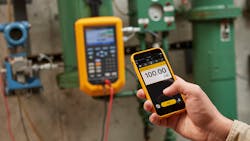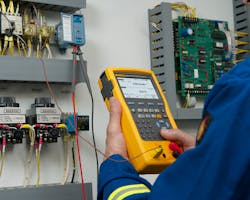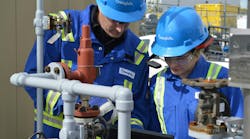In our fast-paced industrial world, today’s processes and systems have become more complex than ever before. And with those complexities, issues can arise. That is why it is essential for your critical processes to operate with the highest level of reliability and accuracy. The right level of routine maintenance and continuous monitoring can help with that.
Routine maintenance and continuous monitoring are two related, but different strategies that can help improve confidence in the measurements your control systems use to maintain critical processes. At the core of each of these strategies is a proactive approach to maintaining equipment and monitoring performance. Instead of acting when something breaks, you plan and act ahead of time, which can help prevent costly downtime, improve safety and increase productivity.
Routine maintenance
Routine maintenance refers to a regular process of inspecting, cleaning, calibrating and repairing equipment to make sure it is running properly. When setting up a routine maintenance program, you will want to include everything from visual inspections to more in-depth diagnostic and calibration performance tests, tailored to your equipment and its intended use.
Keeping track of observations and measurements allows you to catch when something is off or acting up. Often allowing you to adjust or repair equipment before failure can occur. The process can also help you extend the life of your equipment. By routinely checking your equipment and keeping it in good working order, you can avoid the need for costly or unexpected replacements, repairs or process downtime. Good record keeping can also be useful for audits by regulatory agencies.
Routine maintenance example
Say you are responsible for maintaining a valve that controls flow in a critical process of your factory. By performing routine maintenance on the valve, using loop calibrators, acoustic leak detectors, digital multimeters and digital communicators, you can identify potential issues before they become serious problems.
- Checking for pneumatic leaks
- Ensuring the valve is opening and closing properly
- Verifying the valve is properly lubricated (not sticking)
By checking these things, over time, you will build a baseline of normal operating values for this valve. If something is off from the usual measurements or visuals, then you will know to look further into what could be causing the issue. Taking a corrective action can help prevent additional damage in the future, helps eliminate slowing of production or even eliminate down-time for the process to replace damaged or failed equipment.
Continuous monitoring
Continuous monitoring is a step further than routine maintenance. Tools like sensors and data loggers track equipment performance over time. As the measurements are logged, you can gather valuable insights into how your equipment is functioning and identify potential issues before they become larger.
Choosing to monitor your equipment in this way can help you improve accuracy, efficiency and reliability. The data gathered offers real-time information on equipment performance, not only allowing you to identify potential issues before they impact your critical processes, but also allowing you insights into potential opportunities for process improvement. This can help you reduce downtime and waste, improve safety and increase productivity within your facility.
Continuous monitoring example
Say you are responsible for the performance of a critical pump in a chemical processing plant. By using external sensors with a data logger to monitor the pump's flow rate, pressure, vibration and temperature, you can be alerted to any performance changes that might indicate a potential issue. Then, you can act before the pump fails, saving yourself the downtime and avoiding costly repairs. This can also be done autonomously with little technician interaction.
Improving confidence in critical processes
As you continue to run routine maintenance and continuous monitoring programs, the baseline data you gather will grow, eventually pushing you from a proactive maintenance approach to a predictive one. You will learn when certain critical equipment starts to falter, or what signs to look for before issues crop up. All along this process, you will be able to be more confident in the critical points of your process running smoothly and efficiently.
Having the right tools and conducting the right measurements throughout your maintenance and monitoring program walkthroughs can help put you on that track.
Maintenance tools
Digital multimeters
- Use to measure a wide range of electrical signals. Efficiently check measurements like equipment voltage, current, resistance, frequency and capacity.
- To identify issues such as voltage unbalance or short circuits, which can lead to equipment failure and downtime.
Current clamps
- Use to measure the current flowing through electrical circuits.
- To identify issues such as overloading, Inrush and unbalance, which can lead to equipment failure and downtime for repairs.
Infrared cameras
- Use to measure the temperature of equipment safely without contact.
- To identify hot or cold spots, which could indicate equipment stress or insulation issues.
Acoustic imagers
- Use to measure air or gas leaks.
- To identify compressed air, gas or vacuum leaks, which could be causing pneumatic pressure issues down the line. Acoustic imaging allows maintenance teams to quickly diagnose large areas previously requiring lengthy manual leak detection scans as well as providing visibility to all leaks in the target area at once.
Tachometers
- Use to measure the speed of rotating equipment such as motors or pumps.
- To identify possible belt issues or misalignment, which can impact both speed and longevity of your equipment.
Process calibration tools
- Use to calibrate the equipment throughout your facility.
- To maintain accurate processes and verify the specifications of your process instruments. These tools also offer simulation to replace transmitters in the process for troubleshooting operations.
Monitoring tools
Data loggers
- Use to continuously monitor temperature, humidity or pressure over time.
- To identify trends or patterns in equipment performance, which can help alert you to issues before they get too big.
Temperature sensors
- Use to monitor the operating temperature of critical equipment or ambient temperatures.
- To identify potential temperature issues, which can be a sign of a serious problem or help optimize equipment performance. Ambient temperature data might highlight requirements for different operating equipment with improved specifications like certain types of motor cooling.
Pressure sensors
- Use to monitor the pressure of fluids or gases in critical systems.
- To identify leaks or other issues that could impact the performance of the system.
Flow meters
- Use to measure the flow rate of liquids or gases in critical systems.
- To identify clogs or blockages, which can impact the performance of the system.
Vibration sensors
- Use to monitor the vibration of critical equipment.
- To identify misalignment or worn bearings, which can impact the performance and longevity of your equipment.
Routine maintenance and continuous monitoring are two critical strategies that can help improve confidence in critical measurements used by control systems for maintaining critical processes. Using a proactive approach, device performance and equipment maintenance and monitoring, you can identify issues quickly, often repairing them before they become serious problems. This, in turn, can help you reduce downtime, improve safety and increase productivity.
By implementing these programs, you can ensure that your critical processes are operating with the highest level of reliability and accuracy. Taking the steps to build maintenance and monitoring programs ensures the safety and productivity of your operations.
Jim Shields is a process calibration product specialist at Fluke Corporation. He has worked in the field of electrical, temperature and pressure measurement for more than 35 years.



